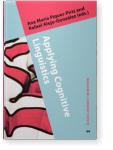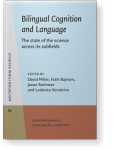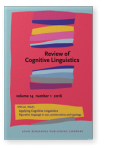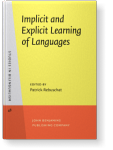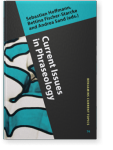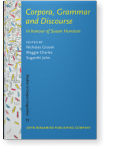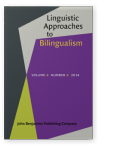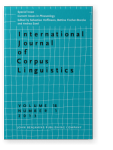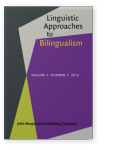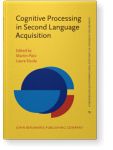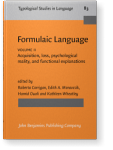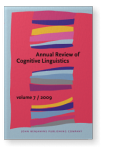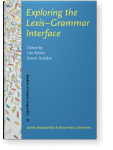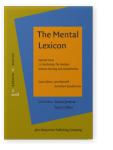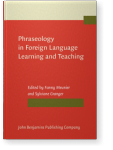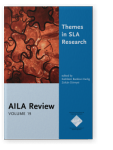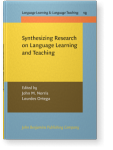Nick C. Ellis
List of John Benjamins publications for which Nick C. Ellis plays a role.
2018 On-line processing of verb-argument constructions: Visual recognition threshold and naming latency Applying Cognitive Linguistics: Figurative language in use, constructions and typology, Piquer-Píriz, Ana M. and Rafael Alejo-González (eds.), pp. 103–132 | Article
Ellis, O’Donnell, and Römer (2014) used free-association tasks to investigateknowledge of Verb-Argument Constructions (VACs). They demonstrated thatEnglish speakers have independent implicit knowledge of (i) verb frequency inthe VAC, (ii) VAC-verb contingency, and (iii) verb prototypicality in… read more
2018 Chapter 3. Usage-based approaches to second language acquisition Bilingual Cognition and Language: The state of the science across its subfields, Miller, David, Fatih Bayram, Jason Rothman and Ludovica Serratrice (eds.), pp. 37–56 | Chapter
We present an overview of the cognitive underpinnings of usage-based approaches to second language acquisition (L2A). Not all constructions are equally learnable, even after years of (frequent) exposure. We present a usage-based analysis of this phenomenon in terms of fundamental principles of… read more
2016 On-line processing of verb-argument constructions: Visual recognition threshold and naming latency Applying Cognitive Linguistics: Figurative language in use, constructions and typology, Piquer-Píriz, Ana M. and Rafael Alejo-González (eds.), pp. 105–135 | Article
Ellis, O’Donnell, and Römer (2014) used free-association tasks to investigate knowledge of Verb-Argument Constructions (VACs). They demonstrated that English speakers have independent implicit knowledge of (i) verb frequency in the VAC, (ii) VAC-verb contingency, and (iii) verb prototypicality in… read more
2015 Implicit AND explicit language learning: Their dynamic interface and complexity Implicit and Explicit Learning of Languages, Rebuschat, Patrick (ed.), pp. 3–24 | Article
Learning symbols and their arrangement in language involves learning associations across and within modalities. Research on implicit learning and chunking within modalities (e.g. N. C. Ellis, 2002) has identified how language users are sensitive to the frequency of language forms and their… read more
2015 The development of formulaic sequences in first and second language writing: Investigating effects of frequency, association, and native norm Current Issues in Phraseology, Hoffmann, Sebastian, Bettina Fischer-Starcke and Andrea Sand (eds.), pp. 83–108 | Article
Formulaic sequences are recognised as having important roles in language acquisition, processing, fluency, idiomaticity, and instruction. But there is little agreement over their definition and measurement, or on methods of corpus comparison. We argue that replicable research must be grounded upon… read more
2015 Chapter 2. Using COBUILD grammar patterns for a large-scale analysis of verb-argument constructions: Exploring corpus data and speaker knowledge Corpora, Grammar and Discourse: In honour of Susan Hunston, Groom, Nicholas, Maggie Charles and Suganthi John (eds.), pp. 43–72 | Article
This paper takes patterns identified in COBUILD Grammar Patterns 1: Verbs (Francis et al. 1996) as a starting point for the systematic, large-scale analysis of English verb-argument constructions (VACs), using both corpus/computational methods and psycholinguistic experiments. We work in an… read more
2014
We used free association tasks to investigate second language (L2) verb-argument constructions (VACs) and the ways in which their access is sensitive to statistical patterns of usage (verb type-token frequency distribution, VAC-verb contingency, verb-VAC semantic prototypicality). 131 German, 131… read more
2013 The development of formulaic sequences in first and second language writing: Investigating effects of frequency, association, and native norm Current issues in phraseology, Hoffmann, Sebastian, Bettina Fischer-Starcke and Andrea Sand (eds.), pp. 83–108 | Article
Formulaic sequences are recognised as having important roles in language acquisition, processing, fluency, idiomaticity, and instruction. But there is little agreement over their definition and measurement, or on methods of corpus comparison. We argue that replicable research must be grounded upon… read more
2010 2. Construction learning as category learning Cognitive Processing in Second Language Acquisition: Inside the learner's mind, Pütz, Martin and Laura Sicola (eds.), pp. 27–48 | Article
2009 The psycholinguistic reality of collocation and semantic prosody(2): Affective priming Formulaic Language: Volume 2. Acquisition, loss, psychological reality, and functional explanations, Corrigan, Roberta, Edith A. Moravcsik, Hamid Ouali and Kathleen Wheatley (eds.), pp. 473–498 | Article
2009 Constructions and their acquisition: Islands and the distinctiveness of their occupancy Annual Review of Cognitive Linguistics: Volume 7, Ruiz de Mendoza Ibáñez, Francisco José (ed.), pp. 188–221 | Article
This paper presents a psycholinguistic analysis of constructions and their acquisition. It investigates effects upon naturalistic second language acquisition of type/token distributions in the islands comprising the linguistic form of English verb-argument constructions (VACs: VL verb locative, VOL… read more
2009 Constructing a Second Language: Introduction to the Special Section Annual Review of Cognitive Linguistics: Volume 7, Ruiz de Mendoza Ibáñez, Francisco José (ed.), pp. 111–139 | Article
This Special Section brings together researchers who adopt a constructional approach to Second Language Acquisition (SLA) as informed by Cognitive and Corpus Linguistics, approaches which fall under the general umbrella of Usage-based Linguistics. The articles present psycholinguistic and corpus… read more
2009 The psycholinguistic reality of collocation
and semantic prosody (1): Lexical access Exploring the Lexis–Grammar Interface, Römer-Barron, Ute and Rainer Schulze (eds.), pp. 89–114 | Article
Our research investigates the psycholinguistic reality in language users of the phenomena of collocation and semantic prosody shown by corpus linguistics to be pervasive in language texts. This report concerns the earliest stages of word recognition and lexical access. It uses a lexical decision… read more
2008 Words and their usage: Commentary on the special issue on the bilingual mental lexicon L2 Vocabulary: The interface between learning and representation, Barcroft, Joe and Gretchen L. Sunderman (eds.), pp. 375–385 | Article
2008 Phraseology: The periphery and the heart of language Phraseology in Foreign Language Learning and Teaching, Meunier, Fanny and Sylviane Granger (eds.), pp. 1–13 | Miscellaneous
2006 Cognitive Perspectives on SLA: The Associative-Cognitive CREED Themes in SLA Research, Bardovi-Harlig, Kathleen and Zoltán Dörnyei (eds.), pp. 100–121 | Article
This paper outlines current cognitive perspectives on second language acquisition (SLA). The Associative-Cognitive CREED holds that SLA is governed by the same principles of associative and cognitive learning that underpin the rest of human knowledge. The major principles of the framework are that… read more
2006 9. Meta-analysis, human cognition, and language learning Synthesizing Research on Language Learning and Teaching, Norris, John M. and Lourdes Ortega (eds.), pp. 301–322 | Chapter
1995 Psycholinguistic Determinants of Foreign Language Vocabulary Learning Lexical Issues in Language Learning, Harley, Birgit, pp. 107–165 | Article
